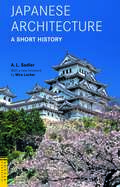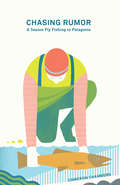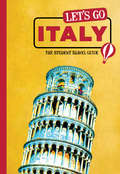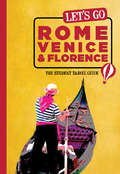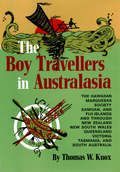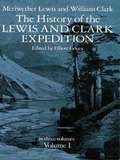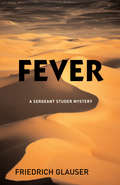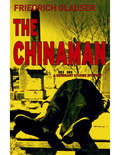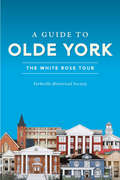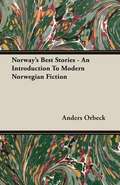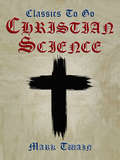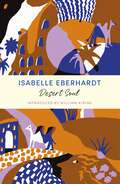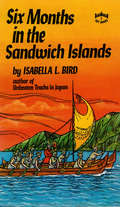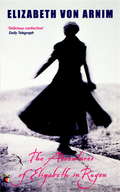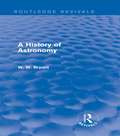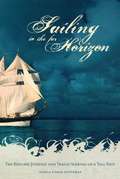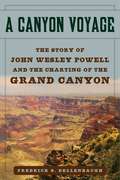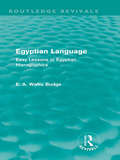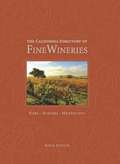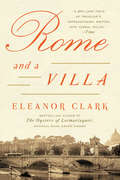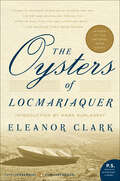- Table View
- List View
Japanese Architecture: A Short History
by A. L. Sadler Mira LocherA. L. Sadler's invaluable study of Japanese architecture first appeared in 1941. Considered a classic in its field, unequaled in clarity and insight, Japanese Architecture A Short History is a lucid and uncomplicated introduction to this important aspect of Japanese culture. Beginning with the earliest evidences from prehistory and ending with the Edo period, when Japan attained stature as a modern state, Japanese Architecture is as relevant today as it was in 1941.
Chasing Rumor: A Season Fly Fishing in Patagonia
by Cameron ChambersEvery November, when the North American rivers turn icy and the grass turns brown, fly fishermen retreat to the fishing holes of their imaginations. Some wander to the banks of the legendary rivers of Patagonia, where the mythical browns measure 20 inches or more and invariably present the fight that every angler lives for. Chasing Rumor is the chronicle of one young angler's attempt to experience the fishing utopia he had created in his mind's eye. In some ways, as with rumors and the imagination, his journey fell short of expectations. But in others, the Patagonian highlight reel he'd created could not possibly prepare him for the adventures of this captivating and mysterious fisherman's mecca in a unique, pristine part of the world. In between catching some amazing trout, Chambers experiences the culture of fishing in Patagonia, one still being carved by both the physical forces of nature and the political, social, and economic forces of man. From John Titcomb, who introduced the fish to the area at the turn of the 19th century, to a business mogul turned B&B owner who popularized guided fishing, from a guide determined to save his local trout population to the anglers themselves and their myriad expectations of each fishing trip, Chasing Rumor takes a circuitous route through history and personality. Along the way, like any reflective fisherman, the author grapples with the environmental contradiction inherent in the origins of this angler's playground, where introduced trout have thrived. How much should man be allowed to alter nature to increase enjoyment of a sport? It is, in fact, a dilemma at the very core of many outdoor endeavors. In the end, Chasing Rumor finds its way back to the fish, however, and how they inspire anglers' commitment to protection of the water. For this reason, the book remains where it belongs, in the great tradition of fishing literature, a world obsessed with the possibility of a ten-pound brown trout.
Let's Go Italy
by Harvard Student Agencies, Inc.Italy is the place for amazing food, the best vino, epic art, unparalleled natural beauties, and some seriously tight leather pants. The Let's Go student researchers endured gallons of gelato, pounds of pizza, miles of museums, countless clubs, and as many ruins as the Romans left behind - all to bring travelers the most comprehensive coverage of Italy, with plenty of witty asides. Get ready to experience adventure and la dolce far niente with Let's Go Italy.
Let's Go Rome, Venice & Florence
by Inc. Harvard Student AgenciesWelcome to Italy, the laid-back land of Roman majesty, Tuscan sunshine, and Venetian romance-at least, that's what they say in the tourist brochures. Our student researchers have lived the real vita bella-dodging rogue scooters, unscheduled bus strikes, and overeager Italian suitors-in order to bring you the coverage that really matters. Their irreverent, in-depth commentary will keep you entertained through scores of Michelangelos and Medicis, and guide you straight to the best gelaterias in town. Whether you're studying abroad in one city or hostel-hopping between all three, Let's Go Rome, Venice & Florence will prepare you for an adventure you'll never forget.Let's Go publishes the world's favorite student travel guides, written entirely by Harvard undergraduates. Armed with pens, notebooks, and a few changes of underwear stuffed in their backpacks, our student researchers go across continents, through time zones, and above expectations to seek out invaluable travel experiences for our readers. Let's Go has been on the road for 50 years and counting: We're on a mission to provide our readers with sharp, fresh coverage packed with socially responsible opportunities to go beyond tourism.
The Boy Travellers in Australasia
by Thomas W. KnoxHere is humor, especially in many of the illustrations; nostalgia and escapism. The author was one of the most colorful and popular figures on the New York scene at the height of his career in the 1880's. This fine book is just one of his many legacies, and is an invaluable contribution toward a better understanding of our fine friends Down Under.
The Boy Travellers in Australasia
by Thomas W. KnoxHere is humor, especially in many of the illustrations; nostalgia and escapism. The author was one of the most colorful and popular figures on the New York scene at the height of his career in the 1880's. This fine book is just one of his many legacies, and is an invaluable contribution toward a better understanding of our fine friends Down Under.
The History of the Lewis and Clark Expedition, Vol. 1
by Elliott Coues Lewis ClarkVolume 1 of the classic edition of Lewis and Clark's day-by-day journals that later became the basis for U.S. claims to Oregon and the West. Accurate and invaluable geographical, botanical, biological, meteorological, and anthropological material. Complete 1893 edition, edited by Elliott Coues from Biddle's authorized 1814 history.
Fever
by Mike Mitchell Friedrich GlauserPraise for Friedrich Glauser's other Sergeant Studer novels:"Thumbprint is a fine example of the craft of detective writing in a period which fans will regard as the golden age of crime fiction."-The Sunday Telegraph"In Matto's Realm is both a compelling mystery and an illuminating, finely wrought mainstream novel."-Publishers Weekly"A despairing plot about the reality of madness and life, leavened with strong doses of bittersweet irony. The idiosyncratic investigation of In Matto's Realm and its laconic detective have not aged one iota."-Guardian"With good reason, the German-language prize for detective fiction is named after Glauser. . . . He has Simenon's ability to turn a stereotype into a person, and the moral complexity to appeal to justice over the head of police procedure."-The Times Literary SupplementWhen two women are "accidentally" killed by gas leaks, Sergeant Studer investigates the thinly disguised double murder in Bern and Basel. The trail leads to a geologist dead from a tropical fever in a Moroccan Foreign Legion post and a murky oil deal involving rapacious politicians and their henchmen. With the help of a hashish-induced dream and the common sense of his stay-at-home wife, Studer solves the multiple riddles on offer. But assigning guilt remains an elusive affair.The third in the Sergeant Studer series.
The Chinaman
by Mike Mitchell Friedrich Glauser"After reading Friedrich Glauser's dark tour de force In Matto's Realm, it's easy to see why the German equivalent of the Edgar Allan Poe Award is dubbed 'The Glauser.'"--The Washington PostPraise for the Sergeant Studer series:"Thumbprint is a fine example of the craft of detective writing in a period which fans will regard as the golden age of crime fiction."--The Sunday Telegraph"In Matto's Realm is a gem that contains echoes of Dürrenmatt, Fritz Lang's film M and Thomas Mann's The Magic Mountain. Both a compelling mystery and an illuminating, finely wrought mainstream novel."--Publishers WeeklyWhen, in later years, Sergeant Studer told the story of the Chinaman, he called it the story of three places, as the case unfolded in a Swiss country inn, in a poorhouse, and in a horticultural college. Three places and two murders. Anna Hungerlott, supposedly dead from gastric influenza, left behind handkerchiefs with traces of arsenic. One foggy November morning the enigmatic James Farny, nicknamed the Chinaman by Studer, was found lying on Anna's grave. Murdered, a single pistol shot to the heart that did not pierce his clothing. This is the fourth in the Sergeant Studer series. Friedrich Glauser is a legendary figure in European crime writing. He was a morphine and opium addict much of his life and began writing crime novels while an inmate of the Swiss asylum for the insane at Waldau.
A Guide to Olde York: The White Rose Tour (History & Guide)
by Yorkville Historical SocietyWelcome to York, a city that can trace its beginnings to the origins of York County, South Carolina. Explore the thirty different styles of architecture in a compact historic district that is listed in the National Register of Historic Places. Within three blocks, discover how an elephant brought Santa Claus into town. Walk the paths of Catawba and Cherokee warriors and chiefs, as well as where leaders and militia rode during the Revolutionary War. And imagine the sights and sounds as Jefferson Davis gave his last public address before the cabinet of the Confederacy dissolved. The Yorkville Historical Society offers this fascinating history and more in a guided tour through the White Rose City.
A Norway Summer
by Laura D. NicholsIt is a long way to Norway, but Ellen's family gives her permission to go. She writes home often. But can romance happen without even a word being spoken?
Christian Science (Classics To Go)
by Mark TwainChristian Science is a 1907 book by the American writer Mark Twain (1835–1910). The book is a collection of essays Twain wrote about Christian Science, beginning with an article that was published in Cosmopolitan in 1899. Although Twain was interested in mental healing and the ideas behind Christian Science, he was hostile towards its founder, Mary Baker Eddy (1821–1910). Twain's first article about Christian Science was published in Cosmopolitan in 1899. A humorous work of fiction, it describes how he fell over a cliff while walking in Austria, breaking several bones. A Christian Science practitioner who lived nearby was sent for, but could not attend immediately and so undertook to provide an "absent healing."
Desert Soul: JM Journeys
by Isabelle EberhardtINTRODUCED BY WILLIAM ATKINS, author of The Immeasurable World 'I am merely an eccentric, a dreamer who wishes to live far from the civilized world, as a free nomad.'Isabelle Eberhardt's writing chronicles, in passionate prose, her travels in French colonial North Africa at the turn of the 20th century. Often dressed in male clothing and assuming a man's name, she worked as a war correspondent, married a Muslim non-commissioned officer, converted to Islam and survived an assassination attempt, all before dying in a flash flood at the age of 27.Desert Soul brings together her 'Wanderings' and 'The Daily Journals', detailing the ecstatic highs and the depressive lows of her short but unique and extraordinary life.
Desert Soul: JM Journeys
by Isabelle EberhardtINTRODUCED BY WILLIAM ATKINS, author of The Immeasurable World 'I am merely an eccentric, a dreamer who wishes to live far from the civilized world, as a free nomad.'Isabelle Eberhardt's writing chronicles, in passionate prose, her travels in French colonial North Africa at the turn of the 20th century. Often dressed in male clothing and assuming a man's name, she worked as a war correspondent, married a Muslim non-commissioned officer, converted to Islam and survived an assassination attempt, all before dying in a flash flood at the age of 27.Desert Soul brings together her 'Wanderings' and 'The Daily Journals', detailing the ecstatic highs and the depressive lows of her short but unique and extraordinary life.
Six Months in the Sandwich Islands
by Isabella L. BirdThis classic of Hawaiian literature offers a charming glimpse at the splendid and fascinating world of pre-American Hawaii.Isabella Lucy Bird won fame in her own time as the most remarkable woman traveler of the nineteenth century, and Six Months in the Sandwich Isles, in which she describes her sojourn in Hawaii in 1873, is one of the gems of Pacific literature. It is safe to say that no other book about Hawaii surpasses it in fascination. Much of the charm of Isabella's writing is due to her use of personal letters for conveying her her experiences and her impressions. The thirty-one letters that compose the book were written to her beloved sister Henrietta, who dutifully stayed at home in Edinburgh to take care of the household while Isabella was away on her travels.The book is an authentic record of daily life in Hawaii in the late nineteenth century. It describes a life style during the brief reign of King Lunalilo, not too may years before the sad reign of Queen Liliuokalani ended her dethronement by revolution. Isabella Bird met royalty, missionaries, cowboys, and ordinary, everyday Hawaiians. It is fortunate that she left such a vivid narrative of her Hawaiian Interlude.
Six Months in the Sandwich Islands
by Isabella L. BirdThis classic of Hawaiian literature offers a charming glimpse at the splendid and fascinating world of pre-American Hawaii.Isabella Lucy Bird won fame in her own time as the most remarkable woman traveler of the nineteenth century, and Six Months in the Sandwich Isles, in which she describes her sojourn in Hawaii in 1873, is one of the gems of Pacific literature. It is safe to say that no other book about Hawaii surpasses it in fascination. Much of the charm of Isabella's writing is due to her use of personal letters for conveying her her experiences and her impressions. The thirty-one letters that compose the book were written to her beloved sister Henrietta, who dutifully stayed at home in Edinburgh to take care of the household while Isabella was away on her travels.The book is an authentic record of daily life in Hawaii in the late nineteenth century. It describes a life style during the brief reign of King Lunalilo, not too may years before the sad reign of Queen Liliuokalani ended her dethronement by revolution. Isabella Bird met royalty, missionaries, cowboys, and ordinary, everyday Hawaiians. It is fortunate that she left such a vivid narrative of her Hawaiian Interlude.
The Adventures Of Elizabeth In Rugen: A Virago Modern Classic (Virago Modern Classics #397)
by Elizabeth von ArnimIn 1901 the 'real' Elizabeth holidayed on the Baltic island of Rügen with just her maid, a coachman, a carriage piled with luggage, and a woman friend. From such unpromising beginnings Elizabeth weaves a captivating farrago around her encounters. There's the snobbish bishop's wife and her personable, handsome son, a dressmaker and, astonishingly, a long-lost cousin -- Charlotte -- who is trying to evade the pursuit of her husband, the maddeningly genial old professor. Here, with delightfully astringent humour, Elizabeth recounts the misadventures that befall her. And, as she immortalised her Pomeranian wilderness in the famous ELIZABETH AND HER GERMAN GARDEN, she now writes enticingly of this remote and attractive island.
A History of Astronomy (Routledge Revivals)
by Walter W. BryantA History of Astronomy, first published in 1907, offers a comprehensive introduction to the steady development of the science since its inception in the ancient world up to the momentous progress of the nineteenth century. It includes biographical material relating to the most famous names in the study of astronomy – Copernicus, Galileo, Newton, Herschel – and their contributions, clear and accessible discussions of key discoveries, as well as detailing the incremental steps in technology with which many of the turning points in astronomy were intimately bound up.
Sailing to the Far Horizon
by Pamela Sisman BittermanOf the legions of wayfarers who shared in the tall ship Sofia's diverse and colorful history, only seventeen were on board when she went down. Of those who survived to tell the tale, none has . . . until now. More than twenty-five years ago, Pamela Bitterman began her journey on board a 123-foot, sixty-year-old sailing ship being readied for its second global circumnavigation. Bitterman's initial voyage, during which Hurricane Kendra chased the schooner miles off course to Bermuda, did not impel her to retreat home. Instead, she immersed herself in this created space between the life of a tall ship sailor, world traveler, and adventurer. Her narrative describes rare gatherings with Cuna Indians in the Gulf of San Blas, the discovery of original ancient tikis hidden away in the Marquesas, and a treasured offering of traditional tapa cloth from island natives. Bitterman's experiences also give readers insight into a time of civil unrest in Latin America, including a frightening road trip through Mexico and Central America, and the chaos during the final stages of the treaty that returned control of the Canal Zone back to Panama. The drama ensues with the arrest of the entire Sofia crew in two different countries, a bout with dengue fever, and a near-mutiny in New Zealand before the final voyage. The details of events from this journey endure as vividly today as when Bitterman was a naive "shellback" swabbie, later ship's bos'un, and finally acting first mate. In the end, she was merely one on a life raft of grateful survivors. Sailing to the Far Horizondraws on original journal entries, photographs, and excerpts from official Coast Guard documents that chronicle the fascinating enigma that was the Sofia and its dramatic end.
A Canyon Voyage: The Story of John Wesley Powell and the Charting of the Grand Canyon
by Frederick DellenbaughIn 1871, seventeen-year-old Frederick Dellenbaugh began a great adventure when he joined Major John Wesley Powell and a crew of scientists on Powell's second exploration trip down the Colorado River and into the Grand Canyon. These were the last great stretches of land and river still unknown in the continental United States. Powell, Dellenbaugh, and the rest of the group spent years exploring the Grand Canyon country, noting its geologic features, and observing its Native Americans inhabitants A Canyon Voyage chronicles this historic expedition, and provides a detailed account of Powell and Dellenbaugh’s historic journey. Through his account the reader can pass through the rapid currents of the Green and Colorado Rivers; climb the crags of the Grand Canyon; trade with the original Native American inhabitants of the Southwest; and witness the picturesque flora and fauna of the area. Brimming with vivid imagery and unbridled adventure, A Canyon Voyage is a perfect read for every armchair adventurer.
Viva Mexico! A Traveller's Account of Life in Mexico
by Charles Macomb FlandreauFirst published in 1908, this is a classic memoir about life in Mexico (from the point of a wealthy foreigner) in the years before the Revolution of 1910. Flandreau describes life on a coffee plantation, and attempts to explain Mexican character and folkways. Although much in this book is overtly racist by today's standards, Flandreau's observations are vivid and his storytelling is often compelling.
Egyptian Language: Easy Lessons in Egyptian Hieroglyphics (Routledge Revivals)
by E.A. Wallis BudgeSir E. A. Wallis Budge (1857-1934) was Keeper of the British Museum’s department of oriental antiquities from 1894 until his retirement in 1924. Carrying out many missions to Egypt in search of ancient objects, Budge was hugely successful in collecting papyri, statues and other artefacts for the trustees of the British Museum: numbering into the thousands and of great cultural and historical significance. Budge published well over 100 monographs, which shaped the development of future scholarship and are still of great academic value today, dealing with subjects such as Egyptian religion, history and literature. The ancient Egyptians expressed their ideas in writing by means of hieroglyphics, which they used uninterruptedly until the end of the rule of the Ptolemies. Evidence indicates that the hieroglyphic system of writing was brought to Egypt by invaders from north-east or central Asia; they settled somewhere between Memphis on the north and Thebes on the south, and gradually established their civilization, religion and methods of communication. First published in 1910, Egyptian Language provides a simple introduction to the study of Egyptian hieroglyphic inscriptions. Including an account of the decipherment of the hieroglyphic system and the general principles which underlie it, as well as the main facts of ancient Egyptian grammar and illustrative extracts, the book will be of value to students and academics of ancient Egyptian language and culture.
The California Directory of Fine Wineries: Napa, Sonoma, Mendocino
by Robert Holmes K. Reka Badger Cheryl CrabtreeThe essential guide to both glamorous estates and intimate, family-owned vineyards, The California Directory of Fine Wineries is an indispensible travel companion to the Golden State's world-renowned wine country. Scenic back roads meander past Napa's elegant tasting rooms, through Sonoma's premier wineries, and into laid-back Mendocino, where the winemakers themselves will pour visitors a glass of their specialty. Profiles cover 68 of Northern California's wineries, describing their striking architecture, bountiful gardens, and distinctive features, from 100-year-old wine caves and museum-quality art exhibitions to bocce ball courts and tastings of local olive oils and other gourmet foods. Also included are more than 200 color images, full-page maps, and sidebars listing directions, vineyard tours, wine tastings, special culinary events, and nearby attractions.
Rome and a Villa
by Eleanor ClarkIn 1947 a young american woman named Eleanor Clark went to Rome on a Guggenheim fellowship to write a novel. But Rome had its way with her, the novel was abandoned, and what followed was not a novel but a series of sketches of Roman life, most written between 1948 and 1951. This new edition of her now classic book includes an evocative foreword by the eminent translator William Weaver, who was a close friend of the author's and often wandered the city with her during the years she was working on Rome and a Villa.Once in Rome, the foreign writer or artist, over the course of weeks, months, or years, begins to lose ambition, to lose a sense of urgency, to lose even a sense of self. What once seemed all-consuming is swallowed up by Rome&$8212;by the pace of life; by the fatalism of the Roman people, to whom everything and nothing matters; by the sheer historic weight and scale of the place. Rome is life itself--messy, random, anarchic, comical one moment, tragic the next, and above all, seductive.Clark pays special attention to Roman art and architecture. In the book's midsection she looks at Hadrian's Villa--an enormous, unfinished palace--as a metaphor for the city itself: decaying, imperial, shabby, but capable of inducing an overwhelming dreaminess in its visitors. The book's final chapter, written for an updated edition in 1974, is a lovely portrait of the so-called Protestant cemetery where Keats, Shelley, and other foreign notables are buried.
The Oysters of Locmariaquer
by Eleanor ClarkWinner of the National Book Award“What an elegant book this is, starting with that most elegant of creatures, the Belon oyster. . . . [Clark’s] fantastic blending of science and art, history and journalism, brings the appetite back for life and literature both.” — Los Angeles Times Book ReviewOn the northwest coast of France, just around the corner from the English Channel, is the little town of Locmariaquer (pronounced "loc-maria-care"). The inhabitants of this town have a special relationship to the world, for it is their efforts that maintain the supply of the famous Belon oysters, called les plates ("the flat ones"). A vivid account of the cultivation of Belon oysters and an excursion into the myths, legends, and rich, vibrant history of Brittany and its extraordinary people, The Oysters of Locmariaquer is also an unforgettable journey to the heart of a fascinating culture and the enthralling, accumulating drama of a unique devotion.
